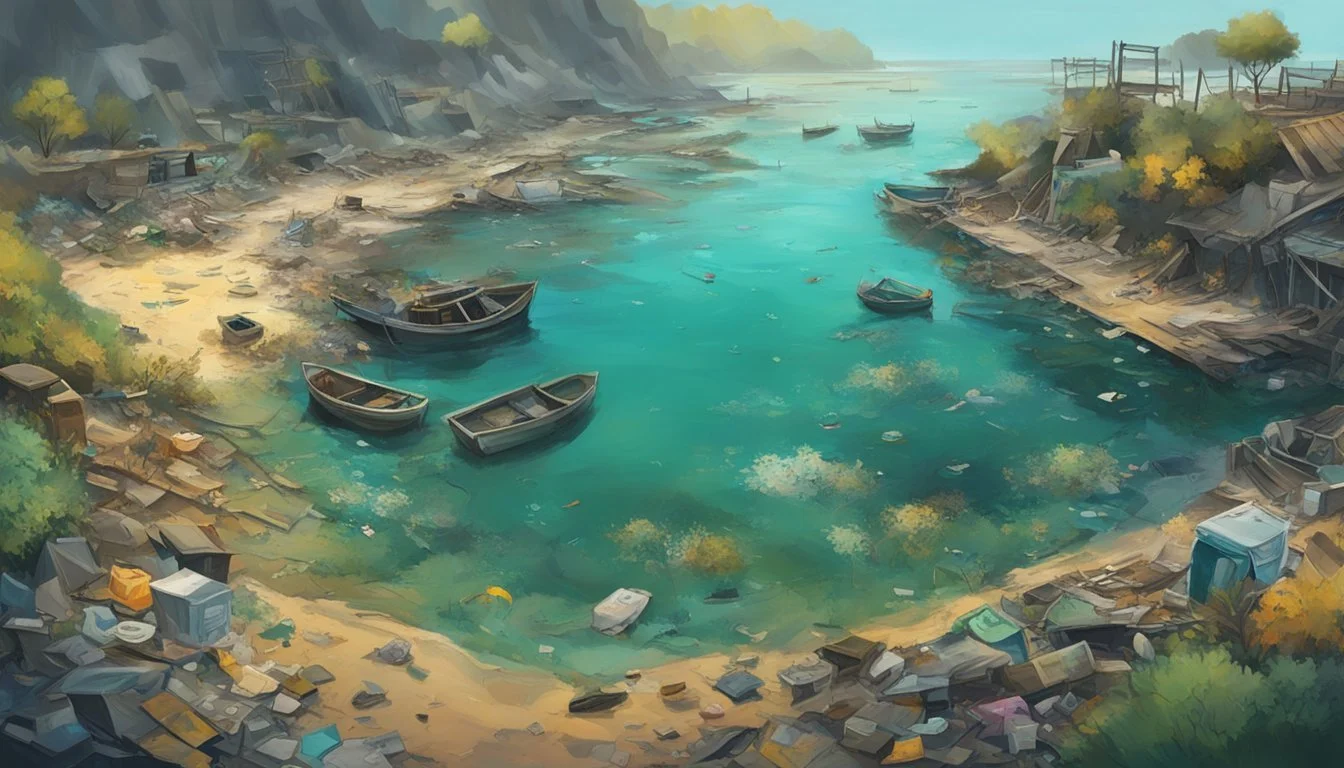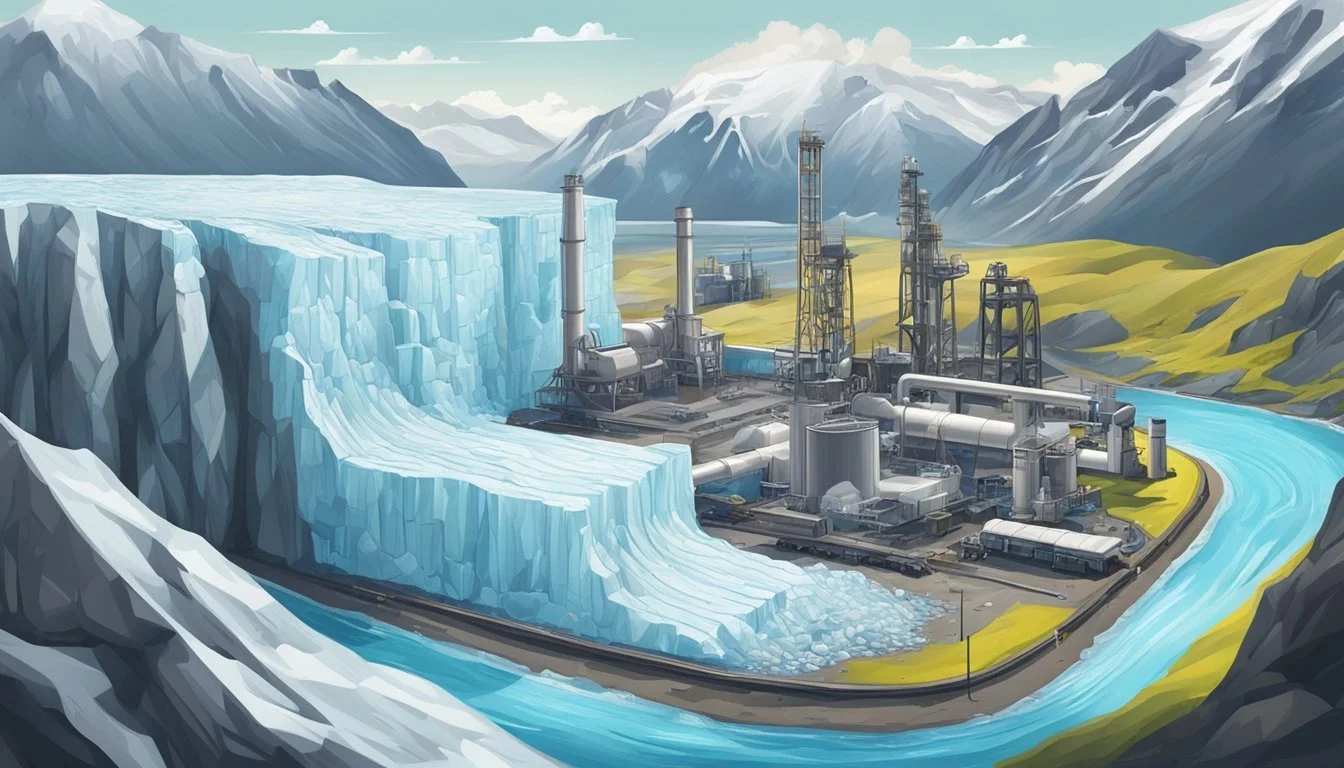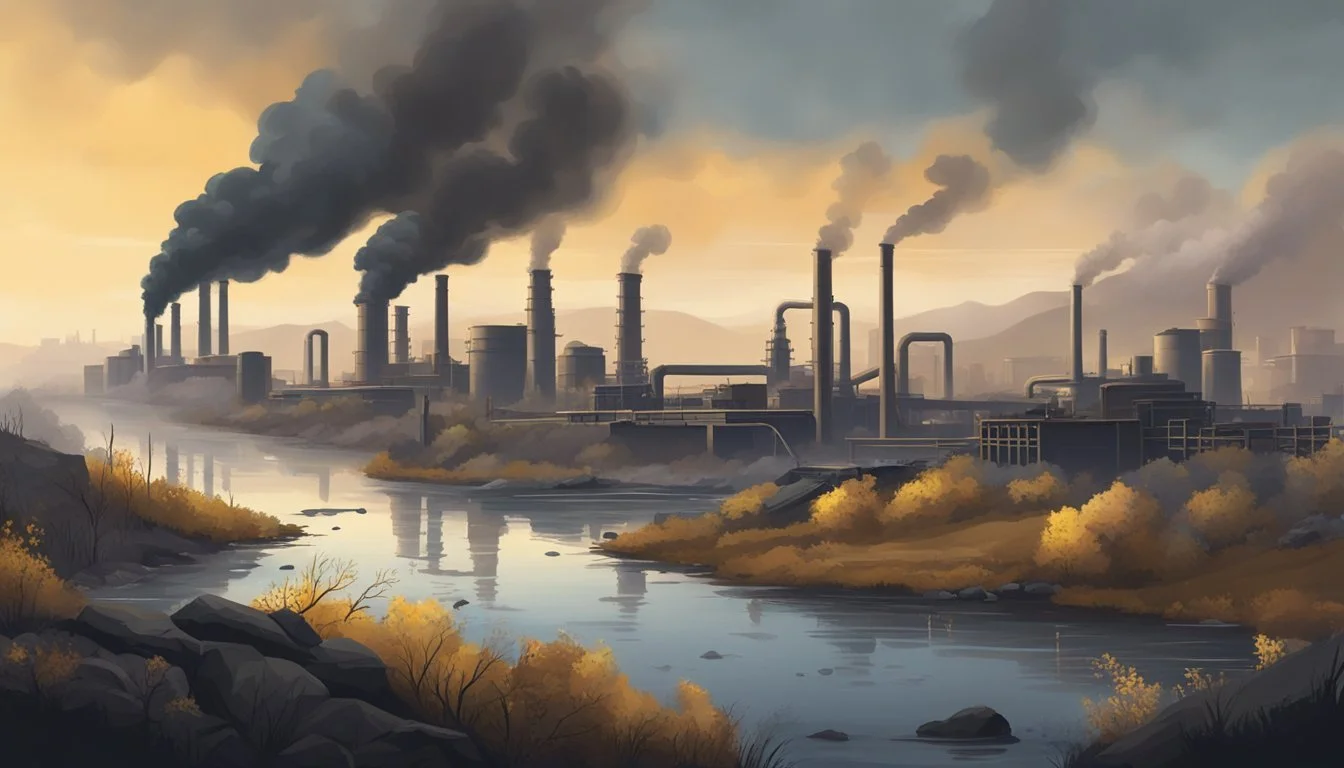12 Shocking Documentaries on Environmental Crimes and Eco-Terrorism
Exposing Hidden Threats to Our Planet
Environmental documentaries shed light on pressing ecological issues and the sometimes extreme measures taken to address them. These films expose viewers to topics ranging from climate change and pollution to corporate malfeasance and radical activism. By presenting real-world events and their consequences, they aim to inform and inspire action.
Documentaries focusing on environmental crimes and eco-terrorism explore the controversial tactics used by some activists to defend the planet. These films often delve into the motivations behind sabotage, property destruction, and other illegal acts carried out in the name of environmental protection. They raise complex questions about the ethics and effectiveness of such methods while highlighting the perceived urgency of ecological threats.
1) The Cove
"The Cove" is a 2009 documentary that exposes the annual dolphin hunt in Taiji, Japan. Directed by Louie Psihoyos, the film follows a team of activists and filmmakers as they secretly document the capture and slaughter of dolphins.
The documentary employs covert filming techniques to reveal the practices hidden from public view. Using hidden cameras and microphones, the team captures footage of the dolphin hunt that had never been seen before.
"The Cove" received critical acclaim and won numerous awards, including the Academy Award for Best Documentary Feature in 2010. It sparked international outrage and raised awareness about the treatment of dolphins in Taiji.
The film combines elements of an eco-thriller with investigative journalism. It showcases the team's efforts to infiltrate the heavily guarded cove where the hunts take place.
"The Cove" not only highlights animal welfare issues but also addresses the broader environmental implications of these practices. It examines the mercury content in dolphin meat and its potential health risks to consumers.
2) Blackfish
Blackfish is a powerful documentary that exposed the dark side of keeping orcas in captivity at marine parks like SeaWorld. Released in 2013, the film focuses on Tilikum, a male orca involved in the deaths of three people.
Through interviews and archival footage, Blackfish reveals the cruel treatment of captive orcas and the dangers faced by trainers. It challenges claims made by the marine park industry about orca lifespans and well-being in captivity.
The documentary sparked widespread public outrage and had significant real-world impacts. It led to declining attendance and revenue at SeaWorld parks. The company eventually announced an end to its orca breeding program and phasing out of theatrical orca shows.
Blackfish raised awareness about the intelligence and complex social needs of orcas. It highlighted how captivity can lead to aggression and other abnormal behaviors in these animals.
The film's influence extended beyond SeaWorld, contributing to broader discussions about the ethics of keeping marine mammals in captivity for entertainment. It remains a landmark documentary in animal rights activism.
3) Cowspiracy
Cowspiracy: The Sustainability Secret is a groundbreaking environmental documentary released in 2014. Directed by Kip Andersen and Keegan Kuhn, the film explores the impact of animal agriculture on the environment.
The documentary follows Andersen as he investigates why leading environmental organizations avoid discussing the effects of animal agriculture. It presents evidence suggesting that this industry is a primary contributor to global environmental issues.
Cowspiracy argues that animal agriculture is responsible for a significant portion of greenhouse gas emissions, deforestation, and water consumption. The film features interviews with experts and activists who provide insights into these environmental concerns.
The documentary gained widespread attention after its release and sparked debates about sustainable food production. It challenges viewers to consider the environmental consequences of their dietary choices.
Cowspiracy's provocative approach and controversial claims have made it a notable entry in the genre of environmental documentaries. The film encourages audiences to question established narratives about environmental conservation.
4) An Inconvenient Truth
Al Gore's 2006 documentary "An Inconvenient Truth" brought climate change to the forefront of public discourse. The film presents Gore's slideshow on global warming, which he had been presenting for years.
The documentary combines scientific data with personal anecdotes to illustrate the urgency of addressing climate change. It showcases melting glaciers, rising sea levels, and extreme weather events as evidence of global warming's impact.
Gore explains complex climate science in accessible terms, making the subject matter understandable for a general audience. The film also highlights potential solutions, including renewable energy and policy changes.
"An Inconvenient Truth" received critical acclaim and commercial success. It won two Academy Awards and significantly increased public awareness of climate change issues.
The documentary's release sparked both praise and controversy. Supporters lauded its role in educating the public, while critics questioned some of its scientific claims and Gore's motivations.
Despite debates surrounding its accuracy, "An Inconvenient Truth" undeniably played a crucial role in bringing climate change to the forefront of environmental discussions and policy debates worldwide.
5) Virunga
Virunga is a powerful documentary that exposes environmental crimes in the Democratic Republic of Congo's Virunga National Park. The film, directed by Orlando von Einsiedel, combines investigative journalism with nature documentary elements.
The documentary follows park rangers as they protect endangered mountain gorillas and their habitat from various threats. These include poachers, armed rebels, and the controversial activities of a British oil company within the UNESCO World Heritage Site.
Set against the backdrop of the violent M23 Rebellion in 2012, Virunga showcases the dedication of conservationists risking their lives to safeguard the park's biodiversity. The film captures intense moments of conflict and danger faced by the rangers and filmmakers.
Virunga sheds light on the complex interplay between conservation efforts, political instability, and corporate interests in one of Africa's most biodiverse regions. It presents a stark portrayal of the challenges faced by those working to preserve natural habitats in conflict zones.
The documentary received critical acclaim for its compelling storytelling and eye-opening revelations about environmental exploitation. It serves as a call to action, urging viewers to consider the global impact of resource extraction and the importance of protecting vulnerable ecosystems.
6) Gasland
Josh Fox's 2010 documentary "Gasland" explores the environmental impacts of hydraulic fracturing, or fracking, in the United States. The film began when Fox received an offer to lease his family's land for natural gas drilling.
Fox embarks on a cross-country journey, visiting communities affected by fracking. He documents cases of water contamination, air pollution, and health issues allegedly linked to nearby drilling operations.
The documentary gained widespread attention for its shocking footage of flammable tap water in some fracking areas. This dramatic visual became a powerful symbol of the potential risks associated with the practice.
"Gasland" sparked significant public debate about the safety and regulation of fracking. It received critical acclaim and numerous awards, including an Emmy and an Oscar nomination for Best Documentary Feature.
The film's release coincided with a boom in natural gas extraction in the U.S. It played a role in raising awareness about fracking's potential environmental and health consequences, influencing public opinion and policy discussions.
7) Our Planet: "Frozen Worlds"
"Frozen Worlds" is an episode from the Netflix documentary series "Our Planet" that explores the impact of climate change on polar regions. Narrated by David Attenborough, the episode showcases the harsh realities faced by wildlife in these icy environments.
The documentary highlights the plight of polar bears, walruses, seals, and penguins as their habitats rapidly transform. Stunning 4K footage captures the beauty of these frozen landscapes while revealing their increasing fragility.
"Frozen Worlds" documents the retreat of mountain glaciers, some receding up to 60 meters in just three years. It also examines the thinning Arctic summer sea ice and its effects on local ecosystems.
The episode sparked controversy with its depiction of walruses falling from cliffs, attributed to habitat loss. This scene underscores the severe consequences of environmental changes in polar regions.
"Frozen Worlds" serves as a stark warning about the accelerating impacts of global warming on Earth's most vulnerable ecosystems. It emphasizes the urgent need for action to protect these unique habitats and their inhabitants.
8) Chasing Ice
"Chasing Ice" documents photographer James Balog's mission to capture visual evidence of climate change. Balog and his team deploy innovative time-lapse cameras to record the retreat of glaciers over several years.
The film showcases stunning imagery of massive ice formations in Greenland, Iceland, and Alaska. It reveals the rapid pace at which these ancient glaciers are melting and disappearing.
One of the most dramatic sequences shows the calving of the Jakobshavn Glacier in Greenland. This event, lasting 75 minutes, is the largest glacier calving ever captured on film.
Balog's Extreme Ice Survey project forms the backbone of the documentary. The photographers face harsh conditions and technical challenges to maintain their camera equipment in remote, icy locations.
The film presents compelling visual proof of the Earth's changing climate. It transforms abstract data into tangible, observable evidence that resonates with viewers on an emotional level.
"Chasing Ice" serves as a powerful tool for raising awareness about the impacts of global warming. It illustrates the urgency of addressing climate change through its breathtaking yet sobering imagery.
9) Sea of Shadows
"Sea of Shadows" is a gripping documentary that exposes the environmental crisis in Mexico's Gulf of California. The film follows a team of dedicated scientists, conservationists, and journalists as they work to save the critically endangered vaquita porpoise.
The vaquita's population has been decimated by illegal fishing practices targeting the totoaba fish. Totoaba swim bladders are highly valued in Chinese markets, leading to a lucrative black market trade.
Director Richard Ladkani captures the dangerous efforts to combat the international crime syndicates involved in this eco-disaster. The documentary showcases the Mexican Navy's attempts to enforce fishing regulations and protect the vaquita's habitat.
"Sea of Shadows" received critical acclaim, winning the Audience Award at the Sundance Film Festival. The film's tense narrative and high-stakes subject matter have drawn comparisons to eco-thrillers.
Ladkani's work sheds light on the complex interplay between environmental conservation, organized crime, and international demand for illegal wildlife products. The documentary serves as a urgent call to action to prevent the extinction of the world's smallest porpoise.
10) Before the Flood
"Before the Flood" is a 2016 documentary featuring Leonardo DiCaprio as he explores the global impacts of climate change. The film takes viewers on a journey across various parts of the world, showcasing the devastating effects of environmental degradation.
DiCaprio interviews a diverse range of individuals, from world leaders to scientists and activists. These conversations provide insights into the complexities of climate change and potential solutions.
The documentary presents striking visuals of melting ice caps, burning forests, and other environmental catastrophes. These images serve to illustrate the urgent need for action on climate issues.
"Before the Flood" also examines the political and economic factors that contribute to climate change. It highlights the influence of fossil fuel industries and the challenges faced by those advocating for cleaner energy alternatives.
The film aims to educate and inspire viewers to take action. It presents information on renewable energy technologies and discusses lifestyle changes that can help reduce carbon footprints.
11) The True Cost
"The True Cost" is a groundbreaking documentary that exposes the hidden impacts of the fashion industry. Directed by Andrew Morgan, this film takes viewers on a global journey to unveil the human and environmental costs of clothing production.
The documentary explores the stark contrast between decreasing clothing prices and the growing toll on workers and ecosystems. It sheds light on the harsh working conditions in garment factories, particularly in developing countries.
"The True Cost" examines the fast fashion model and its consequences. The film highlights issues such as worker exploitation, unsafe working environments, and environmental degradation caused by textile production and disposal.
Through interviews with fashion designers, factory workers, and environmental experts, the documentary presents a comprehensive view of the industry's challenges. It raises questions about consumerism and the true value of clothing in modern society.
The film encourages viewers to consider their purchasing habits and the broader implications of their fashion choices. It serves as a wake-up call to the hidden realities behind the clothing we wear daily.
12) Earthlings
"Earthlings" is a groundbreaking documentary released in 2005 that exposes the harsh realities of human exploitation of animals. Narrated by Joaquin Phoenix and directed by Shaun Monson, the film took six years to complete.
The documentary covers five main areas: pets, food, clothing, entertainment, and scientific research. It uses hidden camera footage to reveal the often cruel treatment of animals in various industries.
"Earthlings" presents a stark and unflinching look at humanity's relationship with other species. It explores how animals are used for human benefit, often at great cost to their welfare and lives.
The film's graphic content and powerful message have made it a significant work in the animal rights movement. It challenges viewers to reconsider their choices and their impact on other living beings.
While not specifically about eco-terrorism, "Earthlings" has influenced discussions on environmental ethics and animal welfare. Its shocking imagery and compelling narrative continue to provoke thought and debate years after its release.
History of Environmental Crimes
Environmental crimes have a long and complex history, evolving alongside human industrial and technological development. These offenses have caused significant ecological damage and sparked global concern.
Early Cases and Awareness
The roots of environmental crimes trace back to the Industrial Revolution. In the late 18th century, air and water pollution became noticeable issues in rapidly growing urban areas. The Thames River in London turned into a toxic sludge by the 1850s, causing widespread disease.
Early conservation efforts emerged in response to overhunting and deforestation. The near-extinction of the American bison in the 19th century raised alarm about wildlife exploitation. In 1900, the Lacey Act became the first U.S. federal law protecting wildlife.
Impact of Industrialization
The 20th century saw a dramatic increase in environmental crimes due to rapid industrialization. Chemical pollution became a major concern after World War II. The Love Canal disaster in the 1970s exposed the dangers of toxic waste dumping.
Illegal logging intensified in tropical regions, leading to massive deforestation. The Amazon rainforest lost significant portions of its area to illegal clearing. Oil spills, such as the Exxon Valdez incident in 1989, highlighted the devastating effects of industrial accidents on marine ecosystems.
Air pollution reached crisis levels in many cities. The Great Smog of London in 1952 caused thousands of deaths, prompting the Clean Air Act of 1956. Similar legislation followed in other countries as awareness of environmental crimes grew.
Understanding Eco-Terrorism
Eco-terrorism involves radical actions carried out in the name of environmental protection. These acts often target property and infrastructure, aiming to disrupt activities perceived as harmful to nature.
Definition and Scope
Eco-terrorism refers to criminal acts committed to further environmental or ecological causes. It typically involves sabotage, property destruction, or threats of violence against individuals or organizations seen as damaging the environment. The FBI has defined it as the use of violence against people or property for environmental-political reasons.
Eco-terrorist tactics may include:
Arson
Vandalism
Tree spiking
Equipment sabotage
Threats and intimidation
The scope extends beyond direct action, encompassing cyber attacks and economic disruption targeting industries like logging, mining, and animal research.
Notable Incidents and Organizations
Several groups have been associated with eco-terrorist activities over the past decades. The Earth Liberation Front (ELF) gained notoriety in the 1990s for a series of arson attacks. In 1998, they claimed responsibility for burning down a ski resort in Vail, Colorado, causing $12 million in damages.
The Animal Liberation Front (ALF) has conducted raids on laboratories and farms, releasing animals and destroying property. In 2003, they targeted Huntingdon Life Sciences, a company involved in animal testing.
Other incidents include:
2001: ELF firebombing of the Center for Urban Horticulture in Seattle
2006: Sabotage of power lines near Snoqualmie, Washington
While eco-terrorism peaked in the early 2000s, concerns remain about potential future actions as environmental issues gain urgency.





